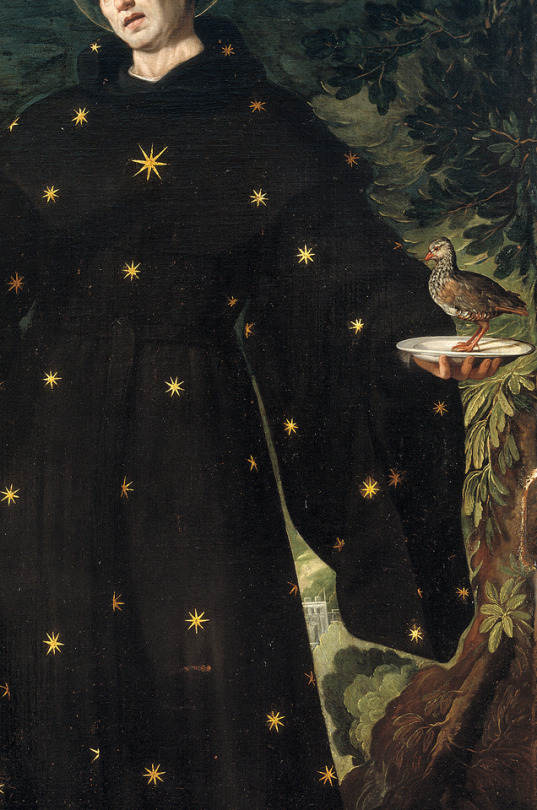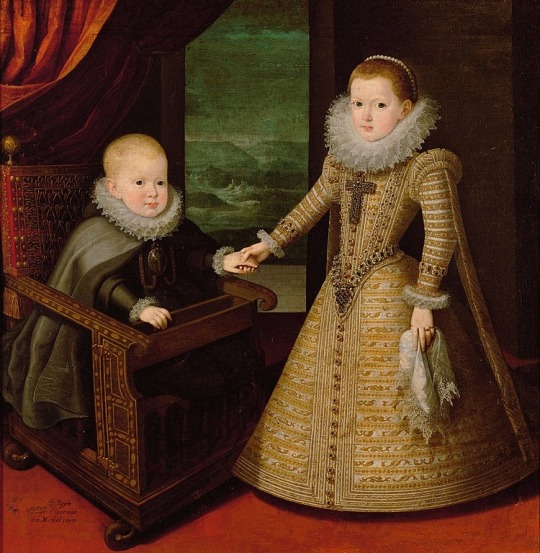#painter is juan pantoja de la cruz
Explore tagged Tumblr posts
Photo

The Spanish painter, Juan Pantoja de la Cruz (1553-1608), was a portrait painter for the Spanish royal family - Dona Catalina de la Cerda, 1602.
#spanish#juan pantoja de la cruz#art#portrait#painting#1600's#royal family#spanish royal family#spanish painter#artist#dona catalina de la cerda
25 notes
·
View notes
Photo

Nicolás de Tolentino (detail) by Juan Pantoja de la Cruz, 1601.
•
Follow: Instagram | Pinterest
#Juan Pantoja de la Cruz#Nicolás de Tolentino#nicolas de tolentino#1600s#17th century#religion#saint#saint nicholas#painting#art history#art#painter#oil painting#stars#history#art detail#portrait
58K notes
·
View notes
Photo

Juan Pantoja de la Cruz, Portrait of Margaret of Austria (1584-1611) (detail), 1606
#1600s#17th century#art#painting#detail#portrait#court painter#court painting#Juan Pantoja de la Cruz#de la Cruz#cruz
952 notes
·
View notes
Text

An adorable portrait of Infanta Ana Maria of Spain (the future Queen Anne of France) holding her little brother Infante Philip (future King Philip IV) of Spain’s hand by Spanish painter Juan Pantoja de la Cruz.
Source: Wikimedia Commons
39 notes
·
View notes
Photo

Unknown artist
Formerly attributed to Juan Pantoja de la Cruz
The Somerset House Conference, 1604
National Portrait Gallery, London (NPG 665)
This group portrait commemorates the peace treaty between England and Spain in 1604 which brought an end to a war which had dragged on for almost twenty years. Between 20 May and 16 July 1604, eighteen conference sessions were held at Somerset House, and the treaty was signed on 16 August. Following the signing of the treaty, England and Spain remained at peace until 1625.
While those depicted were not all present at the same time, the painting may well record the appearance of the room in Old Somerset House where the negotiations took place. On the left are the members of the Hispano-Flemish delegation, on the right, the English commissioners. Although it apparently bears the signature of the Spanish painter Juan Pantoja de la Cruz, this painting also bears an impossible date, 1594. It is generally thought that both signature and the date are false and that it is by a hitherto unidentified Flemish artist. It may be associated with John De Critz the Elder, whose paintings were probably the source for the portraits of Robert Cecil and Thomas Sackville.
#art#juan pantoja de la cruz#john de critz#history#painting#art history#portrait#mannerism#mannerist art#17th century#1600s#17th century art#baroque#baroque art#baroque painting#spain#spanish art#spanish painting#spanish baroque art#flemish art#flemish baroque art
55 notes
·
View notes
Photo

Sofonisba Anguissola [Italian. c.1530/35-1625] Isabel von Valois c.1599 ____
In 1558, already established as a painter, Anguissola went to Milan, where she painted the Duke of Alba. He in turn recommended her to the Spanish king, Philip II. The following year, Anguissola was invited to join the Spanish Court, which was a turning point in her career.
Anguissola was approximately twenty-six when she left Italy to join the Spanish court. In the winter of 1559-1560, she arrived in Madrid to serve as a court painter and lady-in-waiting to the new queen, Isabel von Valois, Philip’s third wife, who was herself an amateur portraitist. Anguissola soon gained Isabel's admiration and confidence and spent the following years painting many official portraits for the court, including Philip II’s sister, Joanna, and his son, Don Carlos. Anguissola's paintings of Isabel von Valois – and later of Anne of Austria, Philip II’s fourth wife/niece – were vibrant and full of life.
During her 14-year residence, she guided the artistic development of Queen Isabel, and influenced the art made by her two daughters, Isabella Clara Eugenia and Catherine Michelle. Anguissola painted a portrait of the King's sister, Margaret of Parma, for Pope Pius IV in 1561 and, after Queen Isabel's death in childbirth in 1568, painted the likeness of Anne of Austria, Philip's fourth wife and niece.
She continued painting portraits at the court. With the gifts and a dowry of 12,000 scudi she earned along with her salary as court painter and lady-in-waiting to the queen, she amassed an admirable return from her craft.
While in the service of Isabel von Valois, Anguissola worked closely with Alonso Sanchez Coello. So closely in fact, that the famous painting of the middle-aged King Philip II was long attributed to Coello or Juan Pantoja de la Cruz. Only recently has Anguissola been recognized as the painting's creator.
#art history#italian painter#spanish court#royals#royalty#noble#nobility#art#painting#oil painting#1500s#beautiful#beauty#history#Sofonisba Anguissola#italy#spain#europe#european#european art#european artist#european royalty#isabel von valois#madrid#anne of austria#phillip ii#realism#king#queen#espana
54 notes
·
View notes
Photo

Workshop of Diego Velázquez
Portrait of the Infanta Maria of Austria, c. 1630
Gemäldegalerie, Staatliche Museen zu Berlin (413C)
On his way back to Spain from Rome, Diego Velázquez “stopped in Naples, where he painted a lovely portrait of the Queen of Hungary, to bring to His Majesty” (Pacheco, 1649). Francisco Pacheco was referring to the Infanta Maria of Habsburg (1606-1646), sister of King Philip IV of Spain, and wife of the King of Hungary, the future Emperor Ferdinand III of the Holy Roman Empire. The sessions took place between 8 August and 18 December 1630, during the four months the queen spent in Naples on her way to Vienna. The painting Pacheco mentions has not been securely identified, though it has traditionally been held to be the one that now hangs in the Museo del Prado (P1187), considered to be an oil sketch for larger paintings intended for the European courts, among them the Berlin canvas. In the Berlin work, the queen is represented in the traditional manner of Spanish court portraits: posing without much artifice against a black background that is decorated only with curtains and leaning against a sillón frailero (armchair with leather seat and back). This type of composition dates back to the sixteenth century, specially to the portrait models that were established by Alonso Sánchez Coello, espoused by Juan Pantoja de la Cruz, and continued by Velázquez and other painters, ending with Juan Carreño de Miranda in the late seventeenth century.

Diego Velázquez. Portrait of the Infanta Maria of Spain, Queen of Hungary; c. 1630 (Museo del Prado, Madrid, Spain)
The German historian Justi categorically rejected the possibility that the Prado portrait was an oil sketch and suggested that the painting now in Berlin is the one Velázquez began in Naples, sketching only the face — which, incidentally, is of higher quality than the body — and leaving the rest for his studio assistants to complete on returning to Madrid. It is difficult to doubt that the Berlin painting was executed by an artist close to Velázquez. Although the brushwork is far removed from the quality and fluidity of the master’s, there is a noticeable attempt to imitate it, such as in the ruff and left hand. As Justi pointed out, the Madrid and Berlin compositions are almost identical, except in the dress and necklace. Although the dress is same in both, the decoration is much more detailed in the Berlin version, and the richness of the fabrich and its embroidery can be appreciated. The necklace, decorated with a pendant with a chalice and Host, is not depicted in the Madrid portrait. The Berlin portrait was on view in the Buen Retiro Palace [Madrid] until 1851, when it was given to Andreas von Schepeler (1780-1849), a German diplomat in Madrid. It was subsequently incorporated into the collection of the industrialist Berthold Suermont (1818-1887), whose collection was purchased in 1874 by the Kaiser Friedrich Museum (now Staatlitche Museen zu Berlin).
— Source: Excerpts from a catalogue entry by María López-Fanjul y Díez del Corral in The Spanish Golden Age: Painting and Sculpture in the Time of Velázquez. ISBN: 978-3-7774-2526-9 (Read more)
#art#history#painting#portrait#velazquez#diego velazquez#baroque#baroque art#baroque painting#17th century#17th century art#1630s#spanish art#spanish baroque art#spain#spanish royalty#prado#museo del prado
56 notes
·
View notes